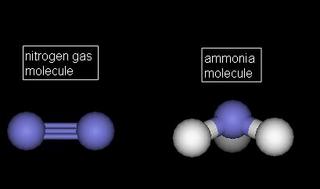The Beauty of Molecule
All matters in the world are made of limited types of atoms through their limitless ways of combinations, called molecules. For example, the table sugar are crystals of sucrose molecules, i.e. enormous numbers of sucrose molecules organized in a repetitive three-dimensional lattice. When a spoon of tiny sucrose crystals is put into water, the lattice collapses and single sucrose molecule enters a sea of water molecules, surrounded by them, a process called dissolution. There are only three types of atoms in a sucrose molecule, carbon, oxygen, and hydrogen. Actually, these three types of atoms plus nitrogen, phosphorous form most of the molecules in our body.

Let's talk about nitrogen. Two nitrogen atoms form a nitrogen gas molecule, countless numbers of which enters your lung each time you breath in air. They do not really enter your body, however; they are breathed out. The molecules enter your body are oxygen gas molecule, formed by two oxygen atoms. So, where do the nitrogen atoms in our body come from? The only way is the food, not in the form of nitrogen gas, but mainly in the form of protein. Not only we cannot use nitrogen gas, neither can the majority of animals and plants.
A small group of microbes that do have the capability of directly using the nitrogen gas produce a very special enzyme (a protein molecule that act as a catalyst, which speeds up conversions of other molecules), called nitrogenase. Nitrogenase speeds up the conversion of nitrogen gas molecule to ammonia molecule, well, actually makes the conversion possible by coupling it with consumptions of a universal biological energy-bill, a molecule called ATP. ATP contains three phosphorous atoms linked energetically by two oxgen atoms, respectively, i.e. lots of energy is released if the link breaks, usually by intervening of a water molecule.
To be able to do this difficult job, so called nitrogen fixation, Nature has built nitrogenase into a very complex molecule. In the last decade, scientists have gained unprecedented insights into how the complex molecular system carry out the difficult job. A recent issue of Science published another milestone paper that will help we human being to understand the beauty of those wonderful molecules.

0 Comments:
Post a Comment
Subscribe to Post Comments [Atom]
<< Home